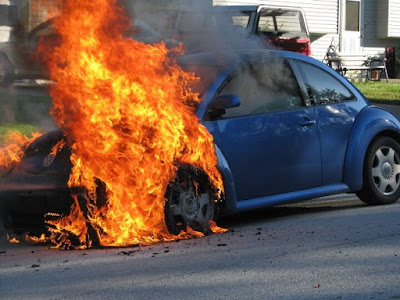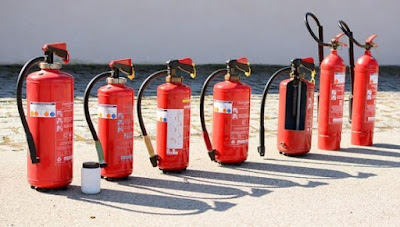Updated: Your Car on fire? Apply these tips provided by FRSC
Have you ever been in a situation where your car caught fire? Some people's car has caught fire while they were driving it. The Nigerian Federal Road Safety Commission (FRSC) has provided tips to apply when fire situation on our automobiles occur.
An automobile (cars, motorcycles, tricycles, buses, trucks, etc.) can start to burn for different reasons such as electrical sparks, faulty wiring, overheating etc. In most automobile fire cases, the fire usually starts from the engine compartment. Steps to follow as soon as your car is on fire include:
1. As soon as an automobile fire is discovered, switch off the car engine and safely discharge off the passengers.
2. Get your fire extinguisher, open the bonnet lightly and discharge fire extinguisher directed to the base of the fire.
3. If possible, disconnect the battery to avoid more sparks.
4. A lot of water may be required for the passenger compartment fire. Also, spraying water on the fuel tank to cool it may be necessary to avoid bursting.
Other steps advised when fire catches your car are:
* All vehicles should park within reasonable distance from the leaking tanker
* Allow only vehicles with spark arrestor fixed to their exhaust pipe to move across
* Discourage/stop everybody within the vicinity from smoking
* Contact fire Brigade as soon as possible
* Apply foam object spray or sand to dissolve the already leaded fuel. Improvise and stop the leaking.
* If the petrol tanker is on fire, clear people from the vicinity and call fire Brigade.
* Be careful around the fire, leave it to the experts.
The classes of fire
For easy identification and extinction purpose, fire is classified into four categories and they are:
Class A: Fire involving free burning materials like wood, paper, textiles, etc. WATER is the best extinguisher agent in form spray.
Class B: Fire involving flammable substances like petrol, paint grease, etc., fall under class B fire. Fire under this category could best be extinguished with LIQUID FOAM extinguisher. Dry chemical powder, Carbon oxide extinguisher and dry sand are also good materials that can be used to put off class B fire.
Class C: Fire involving combustible gases or liquefied petroleum like propane, butane, etc. They can best be extinguished with dry chemical powder and Carbon Dioxide fire extinguishers; water in spray form could be used to cool down the cylinder as well.
Class D: Fire involving metals; e.g. Potassium, Aluminum, Magnesium, Zink, etc., can best be extinguished with Dry Chemical Powder fire extinguisher or dry sand.
Related: How To Prevent Fire Explosion In The Home
Related: How To Prevent Fire Explosion In The Home
Types Of Vehicles And The Amount Of Fire Extinguisher(s) They Should Have – According to FRSC
Fire Extinguisher is an active fire protection device used
to extinguish small fire often in emergency situations.
The dry chemical powdery content is recommended for
automobile fire and FRSC wants us to know how many fire extinguisher canisters we
should have in our vehicles.
See the required quantity of fire extinguisher in vehicles in the attached picture below:
Please, kindly avoid situations that can aggravate a fire situation when using your automobiles. Do share this with your loved ones.
Stay safe.
Stay safe.



Comments